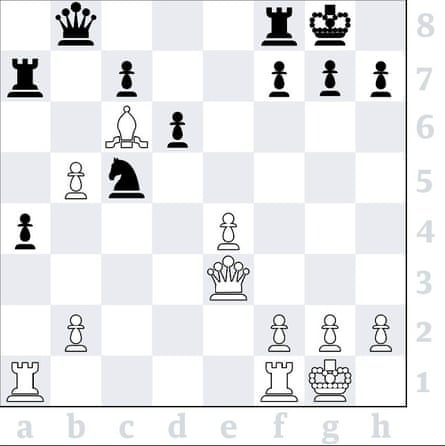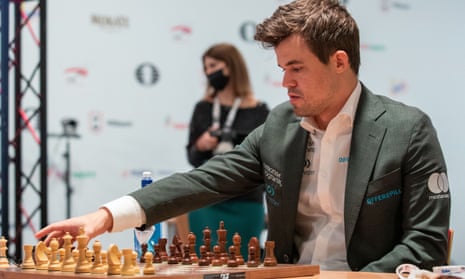Magnus Carlsen will launch his new campaign to achieve a 2900 Fide rating, the Everest of overall tournament performance, when the world champion makes his first move on Saturday (1pm start) in the opening round of the “chess Wimbledon” at Tata Steel Wijk aan Zee. Reaching the round number after being previously twice stalled at 2882 is the 31-year-old’s major target for 2022.
After four successful defences of his global crown, Carlsen says he will only do so again in 2023 if his opponent is the current No 2, Alireza Firouzja, 18, or another grandmaster from the new generation.

Calling the 2900 target an Everest is an apt metaphor. Add on another zero for what used to be calculated as the exact height of the mountain, although it was publicly stated as 29,002 feet in order to avoid the impression that 29,000 was a rounded estimate. There was an Everest expedition a century ago in 1922, two years before the tragedy of the famous 1924 attempt.
Carlsen’s chances of reaching his personal summit are a good deal better than those of George Mallory and Andrew Irvine. His current rating after his world title match in Dubai is 2865, and he will need to score 9/13 at Wijk to gain just a single rating point. A 10/13 total would take him to 2876, within range of his personal bests. He achieved 2882 in Fide’s monthly lists in the years 2014 and 2019, while his unofficial daily peak on the live ratings is 2889.
Having got so close, why has the No 1 not already surpassed his target? His all-time peak tournament performance rating of 3002 was achieved as long ago as 2009 at Pearl Spring, China, which among TPRs of nine rounds minimum ranks second behind Fabiano Caruana’s 3103 at St Louis in 2014. Carlsen’s performance in the first half of 2019 was also well above the required target at 2942.
The problem has been that now and again a sub-par performance creeps in among the glittering successes. One of those was at Wijk 2021, where Carlsen finished only sixth following his shock defeat to Russia’s Andrey Esipenko, then 18. Overall, he has won Wijk seven times, the record number for victories by any player on the windswept Dutch coast, and his opposition for 2022, though of high quality, is missing his two closest rivals in the ratings, Firouzja and Ding Liren.
Firouzja, the world No 2 who quit his native Iran and now represents France, had a spat with the Wijk organisers during the final round in 2021 when he was disturbed by tables being moved to accommodate the play-off for first prize between the Dutchmen Jorden van Foreest and Anish Giri.
The teenager was invited to Wijk 2022, but asked for compensation for the final-day incident, and also wanted a much higher start fee than the organisers offered, so negotiations broke down. Ding, the world No 3, whose tournament appearances in the past year have been drastically few because of China’s difficulties with the pandemic, is also absent from Wijk.
For Carlsen to jump from 2865 to 2900 in the next three weeks would probably require dropping just a single draw in 13 games. More realistic is 9.5/13, a gain of six rating points, which would be enough to show that the champion is en route to his self-imposed target. On the downside, second to Caruana would be disappointing but would still keep Carlsen’s dream alive.
The round-by-round pairings announced on Friday are not ideal for Carlsen, who was given No 11 out of the 14 players and so, like all in the bottom half of the draw, has seven games with Black and only six as White. The world champion opens his campaign on Saturday (1pm start) as Black against Andrey Esipenko, the now 19-year-old who defeated him at Wijk 2021 in the upset of that tournament. In the second round Carlsen has White against his old rival and Dutch No 1 Anish Giri, followed by pairings against the World Cup winner Jan-Kryzsztof Duda and last year’s surprise Wijk winner Jorden van Foreest – who was also a member of Carlsen’s own backroom team for Dubai last month. What could be the tournament decider, Carlsen against the world No 4 and US No 1 Fabiano Caruana, will be in the 12th and penultimate round, and the champion has Black in that game too. To sum up, the rather unkind pairings will be a serious test of Carlsen’s Everest 2900 campaign.
Game Changer by Matthew Sadler and Natasha Regan was a best seller which revealed the secrets of AlphaZero and its free open-source counterpart LeelaZero.
Now Sadler has followed up with The Silicon Road to Chess Improvement (New in Chess, £25), which includes all-computer games as well as training games between computers and the grandmaster author, plus an analysis of significant themes and advice on how to use your own engine to improve your play. Sadler reveals that he used to regularly play two games a day, one with each colour, on his daily commute, losing nearly all of them against Stockfish but analysing them when he got home. He reckons that training games are more useful than the normal practice of checking your own all-human encounter with the website engine after the game is over.
Sadler also analyses the themes, techniques and plans typical of engine strategy. Some of these are already widely known, especially the advance of Harry the h pawn against a fianchettoed bishop, with its ultimate version 1 d4 Nf6 2 c4 g6 3 h4!?
Other ideas will be new to many players. Engines are more ready than humans to seek endgames with bishops of opposite colours, especially with rooks still on the board, with the rationale that dominance of half the board outweighs the risks of reaching a sterile drawn position.

The power of entrenched pieces controlling the game from inside the opposing camp is another engine favourite. Long ago Adolf Anderssen or Wilhelm Steinitz may have claimed (sources are lacking) that with a knight at e6/d6 you can go to sleep and let the game win itself, and the writings of Aron Nimzowitsch show many examples of dominant knights. However, the entrenched piece in the heart of the opponent’s position is more likely to be a bishop.
Today’s top GMs quickly make themselves familiar with useful engine concepts, and there is an example of an entrenched piece in a game played after Sadler’s book was published, in the decisive Maxime Vachier-Lagrave v Jan-Krzysztof Duda tie-break game in the World Blitz final.
Vachier-Lagrave’s Bc6, which is hard to eject or exchange by normal means, dominates Black’s surrounding heavy pieces, and this proved decisive in the game and match.
Silicon Road is a high-level read, which should be most useful to strong and/or ambitious players rated around 2000-plus, or keen juniors 1800-plus. One negative for this reviewer: the book is over 550 pages long, so a thick volume, and the binding is such that only the middle section opens flat.
3798: 1 Nxh6! gxh6 2 g5! hxg5 3 h6 Ne7 4 h7 Ng6 5 Kg2 when the WK advances to g7 and the h pawn queens. In the game Black tried 1 Nxh6 Ke6 2 Nf5 Nxa5 3 Nxg7+ Kf7 4 Nf5 Resigns as White’s g and h pawns will advance.

Comments (…)
Sign in or create your Guardian account to join the discussion